Seema Gandotra, sick with the coronavirus, gasped for breath in an ambulance for 10 hours, as it tried unsuccessfully at six hospitals in India's sprawling capital to find an open bed. By the time she was admitted, it was too late, and the 51-year-old died hours later.
Rajiv Tiwari, whose oxygen levels began falling after he tested positive for the virus, has the opposite problem: He identified an open bed, but the 30-something resident of Lucknow in Uttar Pradesh can't get to it. “There is no ambulance to take me to hospital,” he said.
Such tragedies are familiar from surges in other parts of the world — but were largely unknown in India, which was able to prevent a collapse in its health system last year through a harsh lockdown. But now they are everyday occurrences in the vast country, which is seeing its largest surge of the pandemic so far and watching its chronically underfunded health system crumble.

FILE- In this April 15, 2021 file photo, municipal workers in personal protective suits sanitize themselves after cremating a COVID-19 victim in Vasai, outskirts of Mumbai, India. India's health system is collapsing under the worst surge in coronavirus infections that it has seen so far. Medical oxygen is scarce. Intensive care units are full. Nearly all ventilators are in use, and the dead are piling up at crematoriums and graveyards. Such tragedies are familiar from surges in other parts of the world — but were largely unknown in India. (AP PhotoRafiq Maqbool, File)
Tests are delayed. Medical oxygen is scarce. Hospitals are understaffed and overflowing. Intensive care units are full. Nearly all ventilators are in use, and the dead are piling up at crematoriums and graveyards. India recorded over 250,000 new infections and over 1,700 deaths in the past 24 hours alone, and the U.K. announced a travel ban on most visitors from the country this week. Overall, India has reported more than 15 million cases and some 180,000 deaths — and experts say these numbers are likely an undercounts.
India's wave of cases is contributing to a worldwide rise in infections as many places experience deepening crises, such as Brazil and France, spurred in part by new, more contagious variants, including one first detected in India. More than a year into the pandemic, global deaths have passed 3 million and are climbing again, running at nearly 12,000 per day on average. At the same time, vaccination campaigns have seen setbacks in many places — and India's surge has only exacerbated that: The country is a major vaccine producer but was forced it to delay deliveries of shots to focus on its domestic demand.
Bhramar Mukherjee, a biostatistician at the University of Michigan who has been tracking India’s pandemic, said India failed to learn from surges elsewhere and take anticipatory measures.
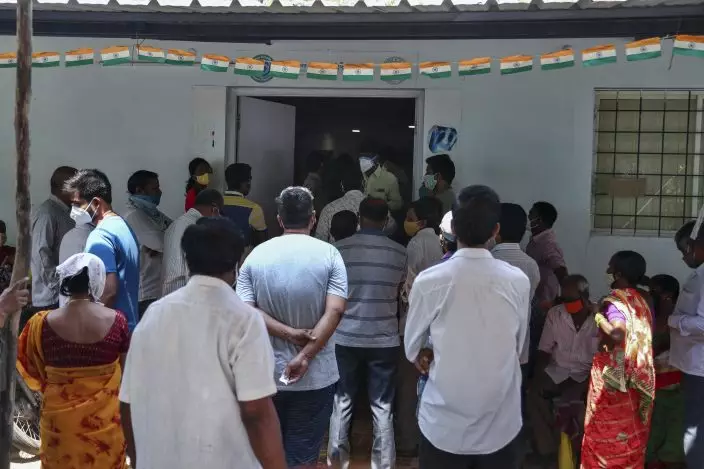
People crowd outside a government hospital to register their names to get vaccinated in Hyderabad, India, Monday, April 19, 2021. India's health system is collapsing under the worst surge in coronavirus infections that it has seen so far. Medical oxygen is scarce. Intensive care units are full. Nearly all ventilators are in use, and the dead are piling up at crematoriums and graveyards. Such tragedies are familiar from surges in other parts of the world — but were largely unknown in India. (AP PhotoMahesh Kumar A.)
When new infections started dipping in September, authorities thought the worst of the pandemic was over. Health Minister Harsh Vardhan even declared in March that the country had entered the “endgame” — but he was already behind the curve: Average weekly cases in Maharashtra state, home to the financial capital of Mumbai, had tripled in the previous month.
Mukherjee was among those who had urged authorities to take advantage of cases being low earlier in the year to speed up vaccinations. Instead officials dithered in limiting huge gatherings during Hindu festivals and refused to delay ongoing elections in the eastern West Bengal state, where experts fear that large, unmasked crowds at rallies will fuel the spread of the virus.
Now India's two largest cities have imposed strict lockdowns, the pain of which will fall inordinately on the poor. Many have already left major cities, fearing a repeat of last year, when an abrupt lockdown forced many migrant workers to walk to their home villages or risk starvation.

Ambulances carrying COVID-19 patients queue up waiting for their turn to be attended at a dedicated COVID-19 government hospital in Ahmedabad, India, Saturday, April 17, 2021. India's health system is collapsing under the worst surge in coronavirus infections that it has seen so far. Medical oxygen is scarce. Intensive care units are full. Nearly all ventilators are in use, and the dead are piling up at crematoriums and graveyards. Such tragedies are familiar from surges in other parts of the world — but were largely unknown in India. (AP PhotoAjit Solanki)
New Delhi, the capital, is rushing to convert schools into hospitals. Field hospitals in hard-hit cities that had been abandoned are being resuscitated. India is trying to import oxygen and has started to divert oxygen supplies from industry to the health system.
It remains to be seen whether these frantic efforts will be enough. New Delhi's government-run Sanjay Gandhi Hospital is increasing its beds for COVID-19 patients from 46 to 160. But R. Meneka, the official coordinating the COVID-19 response at the hospital, said he wasn't sure if the facility had the capacity to provide oxygen to that many beds.
The government-run hospital at Burari, an industrial hub in the capitals' outskirts, only had oxygen for two days Monday, and found that most vendors in the city had run out, said Ramesh Verma, who coordinates the COVID-19 response there.
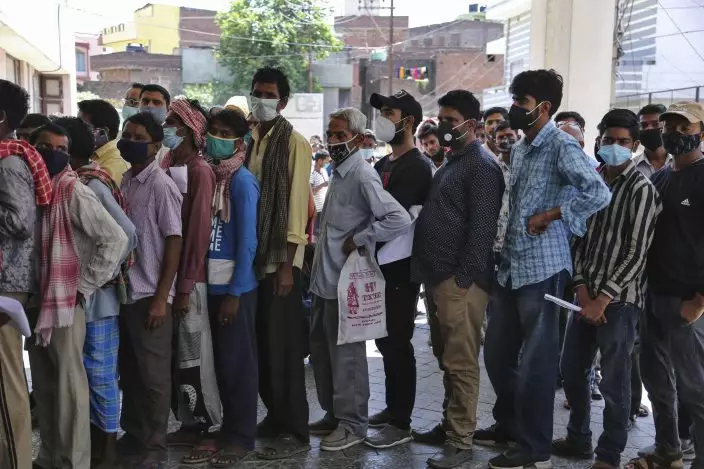
FILE- In this April 19, 2021 file photo, people wearing face masks as a precaution against the coronavirus line up without any physical distancing to get tested for COVID-19 at a government hospital in Jammu, India. India's health system is collapsing under the worst surge in coronavirus infections that it has seen so far. Medical oxygen is scarce. Intensive care units are full. Nearly all ventilators are in use, and the dead are piling up at crematoriums and graveyards. Such tragedies are familiar from surges in other parts of the world — but were largely unknown in India. (AP PhotoChanni Anand, File)
“Every minute, we keep getting hundreds of calls for beds,” he said.
Kamla Devi, a 71-year-old diabetic, was rushed to a hospital in New Delhi when her blood sugar levels fell last week. On returning home, her levels plummeted again but this time, there were no beds. She died before she could be tested for the virus. “If you have corona(virus) or if you don't, it doesn't matter. The hospitals have no place for you,” said Dharmendra Kumar, her son.
Laboratories were unprepared for the steep rise in demand for testing that came with the current surge, and everyone was “caught with their pants down,” said A. Velumani, the chairman and managing director of Thyrocare, one of India's largest private testing labs. He said that the current demand was three times that of last year.
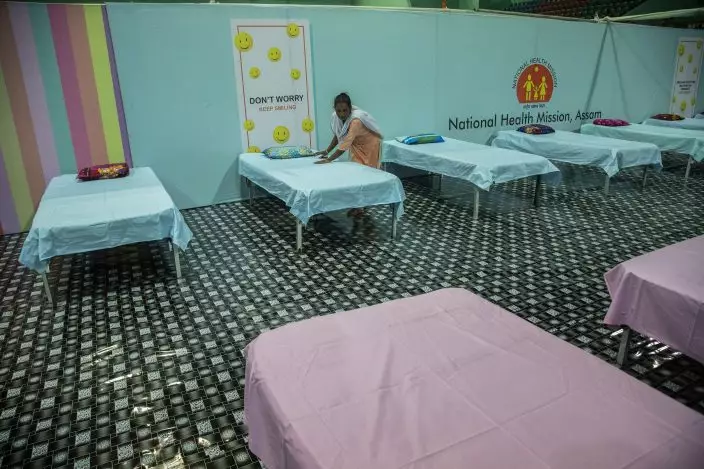
A worker arranges beds at a COVID-19 treatment facility newly set up at an indoor stadium in Gauhati, India, Monday, April 19, 2021. India's health system is collapsing under the worst surge in coronavirus infections that it has seen so far. Medical oxygen is scarce. Intensive care units are full. Nearly all ventilators are in use, and the dead are piling up at crematoriums and graveyards. Such tragedies are familiar from surges in other parts of the world — but were largely unknown in India. (AP PhotoAnupam Nath)
India's massive vaccination drive is also struggling. Several states have flagged shortages, although the federal government has claimed there are enough stocks.
India said last week that it would allow the use of all COVID-19 shots that had been greenlit by the World Health Organization or regulators in the United States, Europe, Britain or Japan. On Monday, it said that it would soon expand vaccinations to include every adult in the country, an estimated 900 million people. But with vaccine in short global supply, it isn't clear when Indian vaccine makers will have the capacity to meet these goals. Indian vaccine maker Bharat Biotech said it was scaling up to make 700 million doses each year.
Meanwhile, Shahid Malik, who works at a small supplier of oxygen, said that the demand for medical oxygen had increased by a factor of 10. His phone has been ringing continuously for two days. By Monday, the shop still had oxygen but no cylinders.
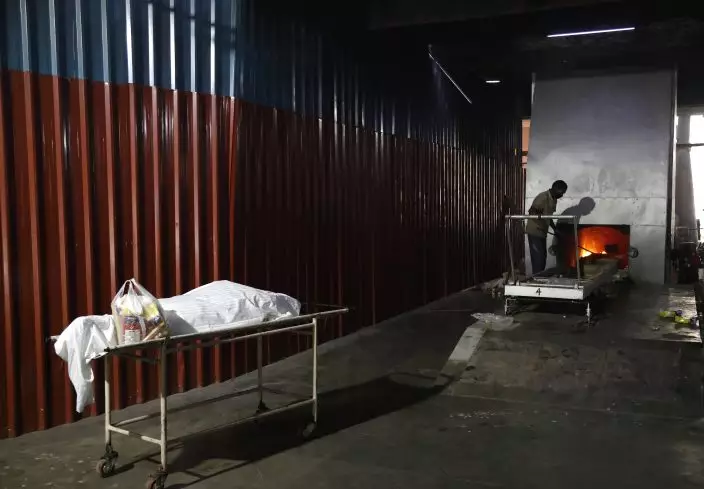
A worker prepares to cremate the body of a COVID-19 victim in New Delhi, India, Monday, April 19, 2021. India's health system is collapsing under the worst surge in coronavirus infections that it has seen so far. Medical oxygen is scarce. Intensive care units are full. Nearly all ventilators are in use, and the dead are piling up at crematoriums and graveyards. Such tragedies are familiar from surges in other parts of the world — but were largely unknown in India. (AP PhotoManish Swarup)
He answered each call with the same message: “If you have your own cylinder, come pick up the oxygen. If you don’t, we can’t help you.”
Associated Press journalists Biswajeet Banerjee in Lucknow and Krutika Pathi in Bengaluru contributed.
The Associated Press Health and Science Department receives support from the Howard Hughes Medical Institute’s Department of Science Education. The AP is solely responsible for all content.
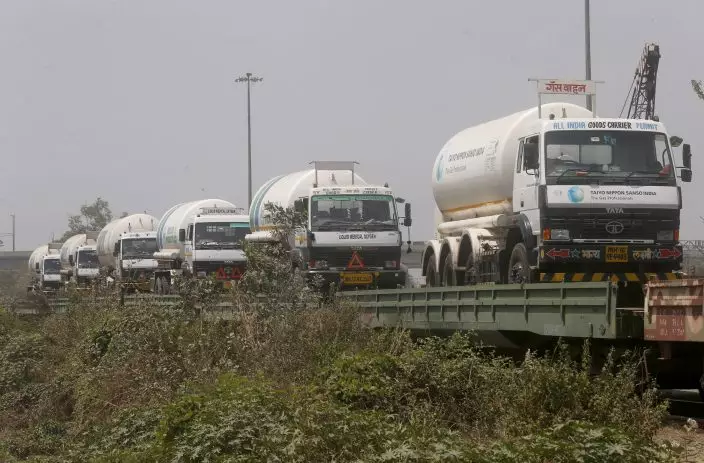
FILE- In this April 19, 2021 file photo, empty tankers are loaded on a train wagon at the Kalamboli goods yard in Navi Mumbai, Maharashtra state, India, before they are transported to collect liquid medical oxygen from other states. The western Maharashtra state, which is worst hit by the coronavirus is facing a shortage of the gas used for the treatment of COVID-19 patients. India's health system is collapsing under the worst surge in coronavirus infections that it has seen so far. (AP PhotoRafiq Maqbool, File)

A health worker takes a nasal swab sample of a passenger to test for COVID-19 in a railway station in Gauhati, India, Monday, April 19, 2021. India's health system is collapsing under the worst surge in coronavirus infections that it has seen so far. Medical oxygen is scarce. Intensive care units are full. Nearly all ventilators are in use, and the dead are piling up at crematoriums and graveyards. Such tragedies are familiar from surges in other parts of the world — but were largely unknown in India. (AP PhotoAnupam Nath)
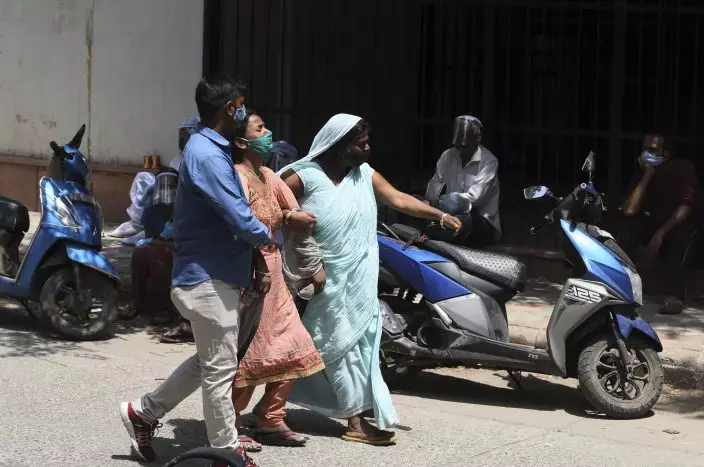
A family wails after identifying the body of their relative who died of COVID-19 outside a mortuary, in New Delhi, India, Monday, April 19, 2021. India's health system is collapsing under the worst surge in coronavirus infections that it has seen so far. Medical oxygen is scarce. Intensive care units are full. Nearly all ventilators are in use, and the dead are piling up at crematoriums and graveyards. Such tragedies are familiar from surges in other parts of the world — but were largely unknown in India. (AP PhotoManish Swarup)
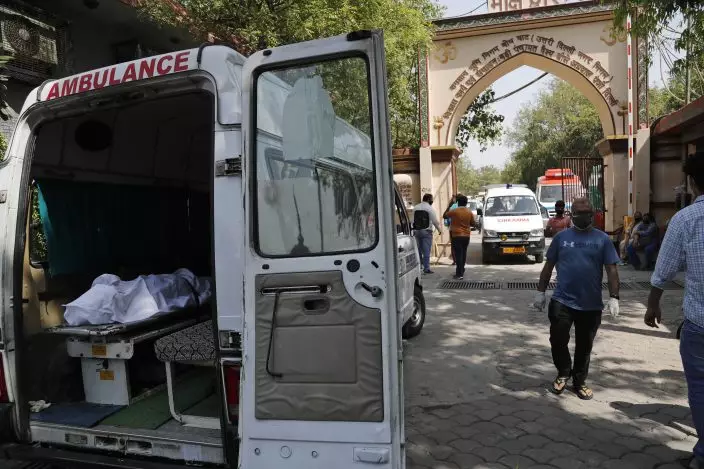
A body of a person who died of COVID- 19 lies in an ambulance for cremation in New Delhi, India, Monday, April 19, 2021. India's health system is collapsing under the worst surge in coronavirus infections that it has seen so far. Medical oxygen is scarce. Intensive care units are full. Nearly all ventilators are in use, and the dead are piling up at crematoriums and graveyards. Such tragedies are familiar from surges in other parts of the world — but were largely unknown in India. (AP PhotoManish Swarup)
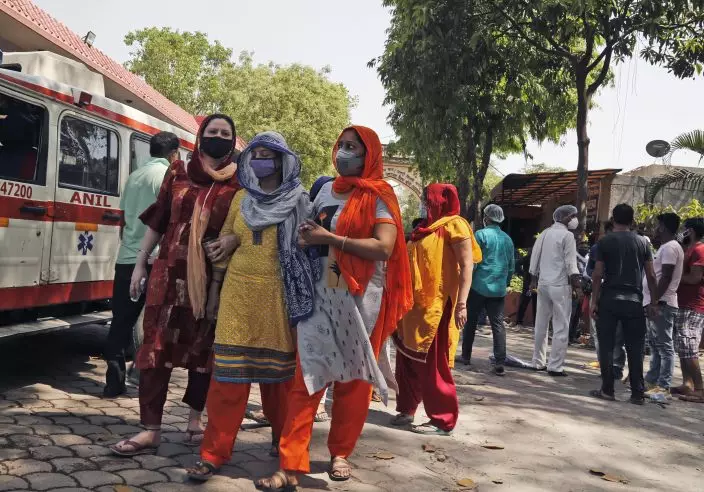
Relatives of a person who died of COVID- 19 leave after cremation in New Delhi, India, Monday, April 19, 2021. India's health system is collapsing under the worst surge in coronavirus infections that it has seen so far. Medical oxygen is scarce. Intensive care units are full. Nearly all ventilators are in use, and the dead are piling up at crematoriums and graveyards. Such tragedies are familiar from surges in other parts of the world — but were largely unknown in India. (AP PhotoManish Swarup)


